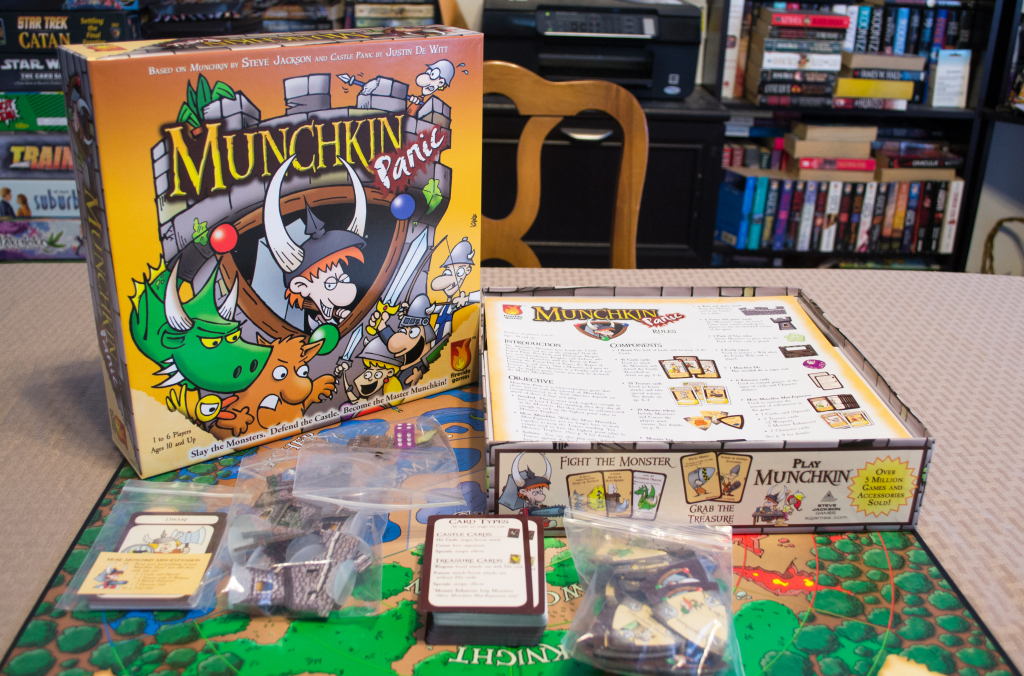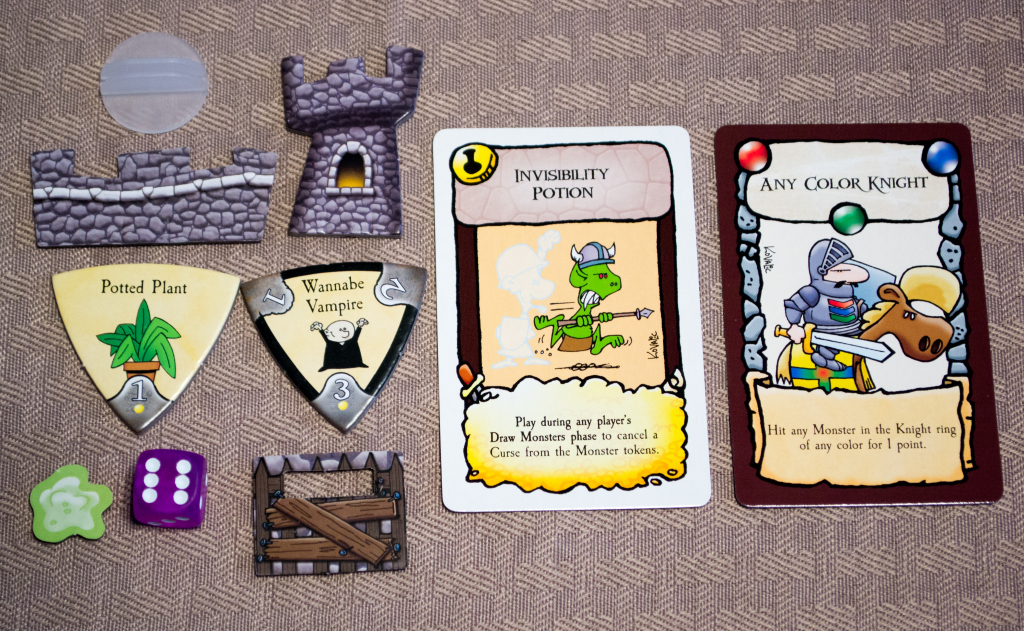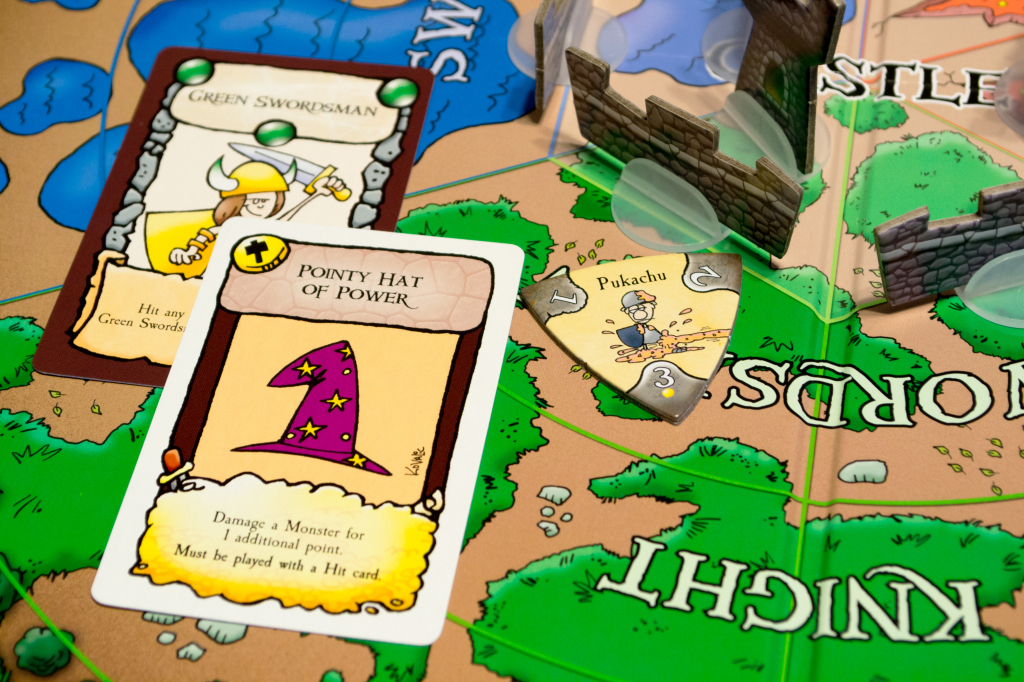I would more than likely be stating the obvious if I told you that “Munchkin Panic” was a cross between “Munchkin” and “Castle Panic”, so I won’t. Erm, yeah. What I will tell you (because I totally didn’t tell you that other thing that I said I wouldn’t mention) is that “Munchkin Panic” is a bit more reminiscent of the latter. If you know how to play “Castle Panic”, you’ll be able to jump right into this so as long as you remember a few key differences. Those who have only played “Munchkin” may feel out of their element, especially if they’ve never played a cooperative or tower defense game before. Before we dive into that realm however, I’d like to thank Kris McCardel, the Marketing and Sales Manager at Fireside Games, for providing me with a free review copy.
Components
Cards – The game includes castle cards, treasure cards, and reference cards. The castle cards are used by players to attack monsters and defend the castle. Treasure cards boost attacks and allow players to take special actions. Reference cards help players keep track of what they can do on their turn.
Monster Tokens & Bag – The monster/curse tokens are what players will need to defeat in order to win the game. A draw bag is used to hold tokens not yet in play or defeated.
Walls & Towers – There are six wall and tower tokens, representing the castle that players must defend.
Flask of Glue & Fortify Tokens – The former sticks monsters in place while the fortify tokens give walls an extra hit point (among other things).
Die – One six-sided die is included and mainly used to spawn monsters onto a particular arc.
More Munchkin Mini-Expansion – Includes one castle card, seven treasure cards, and seven character cards. Experienced players can utilize these to add a bit more depth to their game.
Setup & Gameplay
To keep the review moving, I’ll opt not to go into too much detail regarding game setup. To sum up the process, the walls and towers are set up in the center (one wall/tower for each of the six arcs). Four monsters are spawned from the monster bag (using a separate die roll for each) and placed in the forest ring. Players then receive a particular number of castle and treasure cards depending on how many people are playing the game. If players wish, they can include the More Munchkin Mini-Expansion. I placed a link to the manual below in case you’d like to see the specifics.
A player’s turn is broken up into six phases:
1. Discard & Draw Up – Discard a castle card (optional) and then draw castle cards up to your limit. The limit will change based on how many people are playing. It’s important to stress that your castle card limit is SEPARATE from your treasure card limit.
2. Give Charity – Like castle cards, players can only have so many treasure cards in their hand (based on the number of players). Excess treasure cards are given to the player with the lowest number of trophy points. Each slain monster is worth trophy points equal to the highest number listed on their token. A monster with three hit points is worth three trophy points, for example.
3. Play Cards, Negotiate, & Get Trophies – The current player can play as many cards as they are able in an attempt to kill monsters. When they do, they keep the monster token as a trophy and earn themselves treasure cards. Using cards will discard them. Treasure cards can be combined with castle cards to increase their power as appropriate. The current player can also request help from another player in exchange for whatever they agree upon (the monster token itself, part of the loot/treasure card haul, etc.).
4. Add Treasure to Hand – The current player earns their treasure cards and settles their debts from phase three at this time.
5. Move Monsters – All monsters move forward one space toward the center. Walls and towers each have one hitpoint and go down in one hit, though they also do a point of damage against their attacker. There are some other movement rules to observe that I didn’t cover here.
6. Place Monsters – A certain number of monsters are drawn from the bag and placed separately via die roll. The number of monsters that spawn depends on the number of players.
Players continue taking turns until either all of the monsters are slain (win condition) or all of the towers are destroyed (lose condition). In the case of the former, players will tally their trophy points and whoever has the most, wins! It’s important to note that the win condition is slightly different if players utilize the More Munchkin mini-expansion…in this case, the player with the most trophy points will win regardless if the towers survive.
The above doesn’t cover all of the rules found in the manual, but should give you an idea as to how the game is played. For more information, you can check out the rulebook here:
http://www.firesidegames.com/downloads/MP_RulesWeb.pdf
The Review
At first glance, I didn’t think that “Castle Panic” and “Munchkin” would be a good combination. I mean, they have totally opposite goals. “Castle Panic” is all about working together to kill a common enemy, much like “Pandemic” or “Forbidden Island”. Giving players cards they need is encouraged and almost required in order to win. “Munchkin”, on the other hand, is survival of the fittest with the occasional “scratch my back and I’ll scratch yours (maybe)” mentality. People who do well at “Munchkin” would make excellent Ferengi on “Star Trek”. With that said, “Munchkin Panic” takes the best parts of both games and mashes them together both elegantly and brilliantly. The components were of good quality and I didn’t take issue with anything in particular.
As I mentioned in my opening paragraph, the game is a bit more like “Castle Panic” than “Munchkin”. After all, you have castle cards, towers, walls, goo (instead of tar)…even the names of the rings and the number of arcs are the same. The main difference (and hence where “Munchkin” begins to peak through) lies in the treasure cards and the negotiating that goes along with combat. In “Castle Panic”, only the active player could attack monsters. Here, players can seek the help they need for a price…those who have played “Munchkin” will be familiar with this ancient art of haggling and backstabbing. The backstabbing bit comes more into play when utilizing the expansion as the leading player in trophies will be encouraged to help the monsters destroy the towers.
All in all we enjoyed “Munchkin Panic”. There’s slightly less emphasis on cooperative play when compared to “Castle Panic”, though I thought the earning of treasure cards upon a monster’s death was a neat mechanic. This can also lead to some situations where you’re hesitant to do any damage to a monster IF you can’t finish it off, even if you could. Why give up a great card or two if your opponent gets the last hit and the resulting treasure cards? As I said, you’re less encouraged to work together for reasons like this…though groups who can put aside the greed can treat “Munchkin Panic” as a purely cooperative experience should they wish to. Like “Castle Panic”, the game is highly modifiable to be as friendly or as difficult as you want it to be. This reason alone keeps me coming back to games like “Castle Panic”…the fact that there’s now a bit of mischief to top it off only adds icing to the proverbial cake.
Based on the information I was given, “Munchkin Panic” has a street date of October 8, 2014 and will retail for $39.95.
Final Verdict: 9/10
—
You can learn more about and purchase “Munchkin Panic” by visiting the official site, here:
—




My kids and I played this game tonight. We had fun but the monsters easily defeated us destroying all of the towers.
What we couldn’t figure out was: how do you attack a monster once it reaches the castle?
We had two monsters reach the castle at the same time and we were helpless. None of the hit cards would allow us to target them.
Did we miss something?
Thanks!
Were you applying damage to the monster when they hit each wall/castle stand?
Yes! But monsters that have a minimum hit points of 2 or 3 do not take damage from castle structures once they reach their minimum. They have to be killed with an attack that does 2 or 3 points depending on their minimum value. My guess is that only Hero cards can be used to attack them once they reach the castle and only when they are in the arc of an appropriate color.
If that’s the case, then you’re essentially doomed if a high hit-point monster reaches the castle.
The game is indeed challenging that way. We sometimes opt to spawn monsters every other turn which helps to make the experience a bit more casual. Some may see that as cheating, but I personally enjoy less of a challenge sometimes.
Ken,
I received this note from the developer:
“The only way to directly deal with Monsters that have entered the Castle and started taking out Towers is by using the cards that have a Tower icon on the card. These cards include:
Castle Deck: Flask of Glue, SuperMunchkin, Drive Him Back, Out to Lunch, Wandering Monster
Treasure Deck: Potion of Idiotic Bravery, Potion of Halitosis, Cotion of Ponfusion, and Sleep Potion (Note that the Sleep Potion also has a Tree symbol, which means it affects Monsters in the Forest ring as well!)
Hero cards do NOT work in the Castle ring.”
Thanks so much for this follow-up to my question. This really helps!